Format
Full
City
Shanghai
Country
China
Metro Area
Shanghai
Project Type
Mixed Use
Location Type
Other Central City
Land Uses
Fitness Center
Hotel
Multifamily Rental Housing
Office
Restaurant
Retail
Keywords
Adaptive use
Green building
Innovation district
Live/work space
Pedestrian-friendly design
Science city
Technology companies
Site Size
121
acres
acres
hectares
Date Started
2002
Date Opened
2016
Knowledge and Innovation Community (KIC) is a large, mixed-use technology innovation community developed amid several of Shanghai’s premier universities. Located in the subcenter of Wujiaochang in Yangpu District, about nine kilometers (5.6 mi) from the city center, KIC’s 49 hectares (121 ac) and 762,217 square meters (8.2 million sq ft) of space is designed to foster creative and entrepreneurial culture. The development of this high quality mixed-use urban environment—combining office space with research and development (R&D), educational, training, investment, and incubator services—especially appeals to young people. Through design, programming, and ongoing activities, KIC brings together students, researchers, entrepreneurs, and residents in a “three-zone linkage” of urban office, retail, and mixed-use community.
Access to this robust content is a key benefit of ULI membership.
Become a member today to gain unlimited access to ULI Case Studies.
Become a Member Learn more about membershipThe Site | Development Concept and Team | Development Process and Financing | Development Program | Planning and Design | Marketing, Leasing, and Management | Observations and Lessons Learned | Project Information
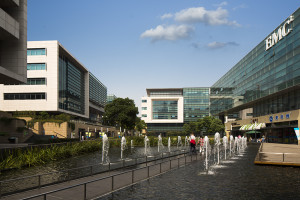
Over the past 12 years, developer Shui On Land, in partnership with the Shanghai government, has gradually developed KIC in three main districts, established it as a knowledge-oriented community that has turned around a declining industrial area, and created a new growth hub in northeast Shanghai.
KIC has attracted large tech firms like EMC², IBM, and Oracle. It is also home to more than 600 Chinese tech companies. The successful transition from a manufacturing powerhouse to a center for the modern creative service economy serves as a model in microcosm for China.
In the early 2000s, the Yangpu District was far from Shanghai’s main business centers around People’s Square and Lujiazui and not an obvious location for a leading creativity and innovation center. Before World War II, Shanghai was a “treaty port,” with much of the wealthy downtown area under foreign control and not subject to Chinese law. Yangpu District was a large industrial center on the periphery and home to thousands of migrant workers crowded into shantytowns. Its political status of being Chinese governed made it attractive for development to the Nationalist government under Jiang Jieshi (Chiang Kai-shek). The 1927 Greater Shanghai plan was to make Wujiaochang (“five corner plaza”), then a regional marketplace, into the new Shanghai government center. The redevelopment plan was abandoned following the Japanese invasion in 1939, but by then, several new government buildings had been constructed. One of them, the Shanghai Municipal Stadium, was built within the boundaries of what is now KIC and has been restored as Jiangwan Stadium, a central part of the project.
Following the war, Yangpu’s industrial strength continued to grow, and by 1990, the district included 30 percent of the city’s factories. But similar to the path of industrial cities around the world—as well as the more central districts of Shanghai—starting in the 1990s, Yangpu found itself with a faltering industrial base and many obsolete and polluted industrial sites, and it was struggling to create a vision for its future. However, Yangpu did have one powerful asset: several higher-education institutions were located close to the site, including Fudan University, Tongji University and Shanghai University of Finance and Economics (SUFE), among others. Although these institutions have about 130,000 students and faculty combined, the district was benefiting little from their presence.
The Site
In 2003, Shanghai’s leaders designated Wujiaochang as one of five major city subcenters to serve as a retail and leisure hub for four districts and 2 million people in the northern part of the city. As part of the redevelopment, the government commissioned a striking new oval structure to enclose the elevated highway. Brightly lit at night, the structure, dubbed “the egg” by local residents, immediately became a regional landmark.
The 49-hectare (121 ac) site that would become KIC occupied a strategic location between the Wujiaochang retail and entertainment center, the Fudan and SUFE university campuses, the Shanghai Second Medical University, and the Jiangwan Stadium, and it is only a short distance north of Tongji University. When the project began, the site encompassed a mix of small factories and worker housing, as well as the stadium and surrounding areas used as a bus depot. The site is bisected by Songhu Road, a major arterial that crosses the elevated Middle Ring Road expressway at Wujiaochang. In 2010, after several phases of KIC had been developed, Shanghai Metro line 10 opened with stops at Wujiaochang and Jiangwan Stadium, putting the entire project site within a few minutes’ walk of the Metro system.
Development Concept and Team

KIC developer Shui On Land, a well-known developer based in Shanghai, is part of the Hong Kong–based Shui On Group, which specializes in large-scale urban core redevelopment projects. Founded by Vincent Lo in 1971, Shui On Land is best known for its successful urban landmark Xintiandi, the winner of the ULI Award for Excellence in 2003. Xintiandi is a cultural center and major tourist destination in Shanghai that preserves the traditional Shanghai lane house architecture known as shikumen. Shui On Land continues to develop other ambitious mixed-use urban districts in other major Chinese cities, such as Wuhan, Chongqing, Dalian, and Foshan.
About the time Xintiandi was being finished, the Shanghai and Yangpu District governments identified the need for a “Science and Education City,” based on the development policy of “build a better city through knowledge and innovation.” They had noted that university districts throughout the world—but not in Shanghai—were centers of innovation, and Shanghai sought a way to take advantage of Yangpu’s strong educational resources. Vincent Lo and Shanghai government leaders began discussing a vision for a technology innovation district that would take advantage of Yangpu’s university cluster, and this vision became the original concept behind KIC.
Shui On Land contributed its philosophy of building integrated communities where people can work, live, learn, and play, and its experience adapting historic structures for new uses and integrating them into redevelopment projects. Shui On Land managers made study trips to innovation and creative clusters around the world, including Silicon Valley and Paris’s Left Bank. The trips helped influence the concept of a knowledge-based community that would integrate the three zones of urban office, retail, and mixed-use community, while fostering an “innovation ecosystem” around knowledge and technology.
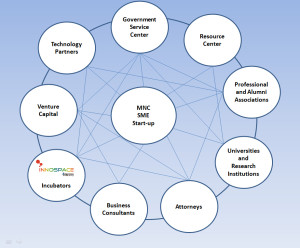
The ecosystem concept influenced not only KIC’s design but also its program. Unlike plans for single-use office park developments, Shui On Land identified uses and functions that would be necessary for a true tech innovation center to emerge, including higher-education institutions, trade associations and institutes, alumni associations, corporate technology partners, venture capitalists, commercial services, legal consultancies, incubators, and government service centers. It then recruited or created these resources and brought them to the development. KIC also provides a comprehensive investment service platform that offers financial assistance, promotion, loan guarantees, and IPO consulting to startups and small enterprises expanding in mainland China. The KIC ecosystem provides a network for tenants and community members, as well as a “sustainable development service system” for innovative companies.
Shui On Land also believes in the value of attracting creative talent interested in a healthy, balanced, and sustainable lifestyle, a concept that is integral to the development. The master plan intentionally strives to foster community, and Shui On Land also provided sustainable buildings and a network of green space, residential space, retail, restaurants, schools, lodging, and sports and leisure facilities and activities. KIC uses “LOHAS,” a popular acronym of “lifestyles of health and sustainability,” to refer to this development and programming emphasis.
Shui On Land retained Skidmore, Owings & Merrill LLP (SOM) to develop the master plan for KIC. For individual buildings, Shui On Land also retained a number of different architecture firms, most of them international, to ensure a diversity of styles in the project. SOM, BWSS, Gensler, Palmer & Turner, Atkins, Farrells, Tianhua, 3XN, Hassell, Leigh & Orange, and AECOM all participated in project design and engineering.
Development Process and Financing

Shui On Land started exploring the opportunity to develop the site in 2002 and officially began the development in 2003, along with the government-owned Shanghai Yangpu University City Investment and Development Co. Ltd. (as a 30 percent partner). The developers financed the KIC project largely with internal funds. Government participation was needed to relocate the existing residents and businesses and to obtain project approvals. At the beginning of the project, both debt and equity financing were used, but because of slow leasing while the project was being developed and the surrounding infrastructure was being installed, the Shui On Group gradually replaced much of the debt with its own equity. At the same time, the government share was reduced to approximately 13 percent.
Development proceeded as parcels of land became available, with the first phase being the office sector on the east side of Songhu Road, next to Jiangwan Stadium. As part of this phase, Shui On Land entered into a 25-year lease to operate the stadium as an event venue (the stadium was the venue for the closing ceremonies of the 2007 Special Olympics and the Shanghai X Games competition) and continues to pay the government rent for the facility. Development for the University Avenue/KIC Village mixed-use district started about the same time.

Subsequent phases extended Class A office space along both sides of Songhu Road, mixed-use retail and live/work along University Avenue, and a high-end condominium development across from Fudan University. At the same time, KIC’s supporting program deepened as a web of strategic partnerships was constructed, and functions such as a business accelerator and the district government business service center were opened. The last phase of development, on the northwest corner of the site, includes establishing the Fudan University School of Management (for which Shui On Land provided the land and in return asked the school to build an open campus), a boutique hotel, and a kindergarten. As of early 2015, development of KIC is nearly complete: the office and retail portions are built and over 90 percent leased, and the residential and live/work portions are built and sold. The final phase is in construction and fitout and will open within the next two years.
Development Program

KIC is divided into three districts: KIC Plaza/KIC Corporate Avenue, University Avenue/KIC Village, and the Jiangwan Stadium area. It also includes residential, educational, and hotel projects to the north of KIC Village.
KIC Plaza/KIC Corporate Avenue. KIC Plaza and KIC Corporate Avenue together constitute the flagship office and R&D center of the project. Their 190,279 square meters (2.0 million sq ft) of office space hosts more than 50 international corporate tenants in software, design, finance, and cloud computing, including companies such as IBM, Oracle, Deloitte, China Telecom, EMC², and eBaoTech. Smaller tenants that add to the innovation ecosystem include the offices of international educational institutions such as the University of Leeds, the University of Melbourne, the Chinese University of Hong Kong, Boston University, and the China branch of Silicon Valley Bank. KIC Plaza flanks Songhu Road on both sides and is directly adjacent to the Jiangwan Stadium Metro stop. This district also includes 45,173 square meters (486,000 sq ft) of retail space in KIC Plaza, primarily consisting of food and beverage (F&B) services for the offices, commercial education, children’s education, activity centers, and training tenants.
KIC Plaza also is home to InnoSpace, a flex-space technology startup accelerator that opened in 2011 and expanded to a second phase a year later. InnoSpace is an entrepreneurship service platform for startups, providing physical space, infrastructure, technological support, financing services, personnel recruitment, market promotion, and other exclusive entrepreneurship services that are part of the KIC platform.
At any given time, InnoSpace hosts approximately 60 tenants who sign up for three-month leases. Following the business model of Y Combinator and other well-known tech accelerators, this business incubator model is common in the West but at the time was groundbreaking for China. Over 50 percent of InnoSpace participants go on to get additional venture funding, and many startups graduating out of InnoSpace move to one of the small office/home office (SOHO) units on University Avenue. Through this method, KIC is generating its own future tenants.
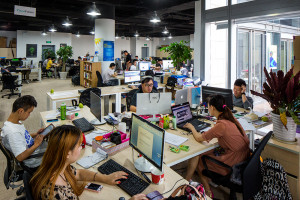
University Avenue/KIC Village. KIC Village is KIC’s mixed-use small business and startup district, home to more than 400 small businesses and 200 startups. Centered around a lively retail and F&B street, the area is meant to recall its namesake, University Avenue outside Stanford University in Silicon Valley. It includes four mid-rise buildings with 28,497 square meters (307,000 sq ft) of live/work units and is more commonly known as SOHO units. Although SOHO units are not uncommon in Chinese developments, this designation often has been simply a way for developers to sell residential units in a more commercially zoned district. Shui On Land’s SOHO units were designed with true live/work occupants in mind, and more than half are in fact being used commercially.
Adjacent to the SOHO buildings and facing a small central square is a key institutional use: the Yangpu District government’s Overseas Talent building, which helps Chinese who are returning from study and work abroad with residence and work permits and offers its own incentive funding programs for startup businesses. Across the street is the IPO Club, a startup-oriented café that offers social and educational programs for entrepreneurs.
The neighborhood targets young creative workers, university students, and residents looking for a lively and health-conscious environment. The 13,670 square meters (147,000 sq ft) of retail and F&B uses includes a number of fitness and informal fashion brands and receives about 10,000 visitors a day. The F&B is heavily occupied by coffee shops and inexpensive to midrange international restaurants, including Thai, Italian, and Mexican. Shui On Land purposefully tenants the F&B with unique restaurants; it has only two chain outlets, and one of them is local. Several F&B offerings, including the popular bar Homeless, were started by local university students or returning foreign scholars.
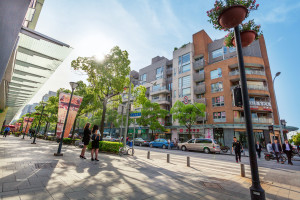
Surrounding University Avenue are 709 units of midmarket, for-sale apartments of relatively small sizes (70–130 square meters [750–1,400 sq ft]), totaling 78,449 square meters (844,418 sq ft).
Also in the area are:
• Jiangwan Regency: A high-end condominium project with 240 units ranging from 170 square meters (1,830 sq ft) to over 200 square meters (2,150 sq ft) of space;
• Fudan University School of Management: 102,000 square meters (1.1 million sq ft) built by the university on 6.3 hectares (15.5 ac) of land provided by the developer, on the condition that the campus is open to the public; and
• Boutique hotel: a 146-room, approximately 15,000-square-meter (818,000 sq ft) hotel, which will open in 2017; the operator is not yet confirmed.
Jiangwan Stadium area. Jiangwan Stadium is a sports and cultural area centered on the former historic Shanghai Municipal Stadium, built in 1935. The stadium sits at the head of a grassy quad, flanked on both sides with the office buildings of KIC Plaza. It hosts sports and entertainment events, and the area also includes public indoor and outdoor basketball courts and a swimming center. An Art Center hosts performances from international artists, and the area includes 8,798 square meters (95,000 sq ft) of mostly sports-related retail space.
Planning and Design

The master plan of KIC centers on several key objectives. The first strategic objective was to develop an open, mixed-use plan that would physically connect the university, office users, and the community and promote interaction among these different groups. The second objective was to create a direct east-to-west pedestrian spine between Fudan University and the restored Jiangwan Stadium in the form of a lively retail street. And the third objective was to create a high-quality, active, sustainable environment that could attract both firms and talent. Small blocks, mixed-use blocks, and a dense road network are key to this type of environment.
Sustainability. KIC’s focus on sustainability was important to attract creative talent to live and work in the district. Shui On Land builds to sustainable standards in most of its developments, and KIC has preliminary registration under LEED (Leadership in Energy and Environmental Design) Neighborhood Development, with individual buildings certified under Commercial Core and Shell at levels from LEED Certified through LEED Platinum, or the Chinese Green Star rating, or both. KIC’s own management and leasing office is registered under Commercial Interiors at the LEED Gold level. The certification level of the office buildings has increased over time, with the most recent KIC Corporate Avenue office buildings being precertified LEED Platinum. This decision was driven by a desire to make the office space stand out in a market projected to be crowded with green buildings and as a statement for the last phase of the project. The buildings feature sophisticated systems to monitor and control daylight, ventilation, and energy use, such as ice-based energy storage, green roofs, and rainwater collection. One project in the development has received RMB 2.5 million of government grants for being a pilot project in energy savings.

Walking and biking. KIC combines a number of features to encourage walking and biking. The district is composed of many small blocks connected by narrow streets and plazas, using high-quality pedestrian infrastructure. The highly mixed land uses (including many live/work units), strong connection to nearby universities, direct subway access, and a bike-share station gives all visitors and residents accessibility to easily walk and bike on their daily errands.
Density. Although it is located in one of Shanghai’s major activity districts, KIC is less dense than many of the city’s neighborhoods. Because of height restrictions surrounding the stadium, the development has no high rises: the tallest buildings are ten to 12 stories. The Class A office space is mostly four to eight stories and is classified by real estate brokers as a business park rather than as a downtown office. Despite the large amount of green space and relative lack of density, KIC’s mixed uses and strong pedestrian connections give it many of the advantages of urban neighborhoods.
Marketing, Leasing, and Management
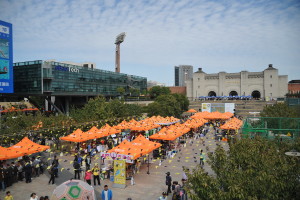
Shui On Land actively manages project marketing, commercial leasing, promotion, and partnership management from its on-site office.
Marketing and leasing. To date, market reception for KIC has been good. Office rents are among the highest of any Shanghai business park and up to 30 percent higher than other office space in Yangpu. In 2011, Shui On Land sold one building in KIC Plaza Phase III to the Industrial and Commercial Bank of China for RMB 600 million (US$98 million), or RMB 37,750 per square meter (US$566 per sq ft) for the office space, a price more commonly associated with central business district office space than business park space. The development’s office space is now 90 percent occupied.
In part because of some development difficulties, such as a slow resident relocation process and prolonged Metro station construction, University Avenue retail took several years to become established, but it is now fully occupied with successful tenants and has become a popular regional destination. Overall, KIC’s retail space is over 90 percent occupied.
KIC’s residential space has also been well received. The middle-market and live/work KIC Village units sold quickly, with sales prices rising from RMB 17,800 to RMB 28,000 per square meter (US$267 to US$420 per sq ft) from 2007 to 2009. Jiangwan Regency sold 70 percent of available units on the first day of launch in late 2013, for an average sale price of RMB 40,000 per square meter (US$599 per sq ft). All residential units are now sold.

Events, promotion, and partnerships. Shui On Land continues to actively manage KIC’s innovation ecosystem to ensure that the different parts of the development remain in balance and are ever evolving to stay current with the changing needs of entrepreneurs. KIC offers more than 100 events every year aimed at entrepreneurs and technology workers, such as Global Entrepreneurship Week, Global Hackathon, Maker Carnival, the Social Entrepreneurship and Social Venture Capital Summit, a Cloud Computing Forum, and several TEDx forums. It also sponsors social events, which have included a Grand Christmas Party, the Cyber Games, a LOHAS carnival, a charity flea market, a farmers market, drama appreciation, and a pet party. These events attract a million visitors annually and promote the area as a center for technology and social innovation. KIC is a leader in promoting its events and space on social media and recently won awards for its marketing efforts in the real estate category from both SinaWeibo and TencentWeixin, the two most popular social media platforms in China.
KIC has carefully cultivated a network of institutions as a driver for business leasing. A partnership with Hong Kong’s Cyberport IT district allows the two projects to cooperate on information sharing, talent exchange, and international marketing. Its study relationship with Silicon Valley has turned into a partnership; both the Bay Area Council and the California Trade Office have offices in the development, and KIC has become a beachhead for international investors—especially American—who are interested in Chinese technology companies. KIC gives roadshows in Silicon Valley to attract companies planning to come to China; one valuable result of this outreach was the signing of Silicon Valley Bank’s China office (a joint venture with the local Pudong Development Bank), which brings both international investors and local tech companies to the development. The relationship goes two ways, because some of the startups working in InnoSpace specifically target the American market. Finally, KIC pursues relationships with alumni organizations of leading technology institutions and organizes alumni events.
KIC also works closely with city economic development initiatives and benefits from several city-level policies meant to encourage innovation across Shanghai. One is the Greater Zhangjiang policy, named for the powerful Zhangjiang R&D business park in Shanghai’s Pudong New District, which is intended to spread innovation throughout the city; it states that businesses in KIC can take advantage of any incentive or concession offered to businesses in Zhangjiang. Another is the city policy that district governments need to provide a certain common level of tax receipts from creative and business parks to the city before they can offer district-level incentives. This limits competition between districts offering incentives and allows KIC to compete on overall cost and service value, rather than trying to match incentive levels from other parks.
Observations and Lessons Learned
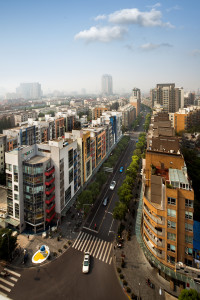
KIC’s success in becoming much more than a typical business park illustrates the importance of a well-thought-out program and of the functions and services supporting the development. Shui On Land’s persistent emphasis on openness, mixing uses and markets, and building a complete ecosystem allows KIC to stand out in a crowded market. Its introduction of the university and the community into the development has enabled KIC to become a neighborhood as well. KIC is a unique project that cannot be simply replicated anywhere, but it provides lessons for developers in establishing industry clusters, assembling strategic industry partners, and understanding clients. Shui On Land calls the industry ecosystem it has modeled for KIC the single most important factor distinguishing it from its competitors.
Challenges. Several of the innovative concepts used during the development of KIC presented challenges in design and approval, lengthening the time for completion and stabilization. For example, the outdoor café seating envisioned by the developer and designer was a new concept that was hard for the district-level officials in charge of permits to grasp. They were familiar with only illegal food stands and were concerned that serving food on the street would result in a low-end and disorderly environment. Café umbrellas and outdoor seating were forcibly cleared by district “city management” department employees several times before the developer was able to make its intentions acceptable to officials. Having multiple international designers work on the KIC Village buildings also presented challenges; several designs were not sufficiently tailored to the local market and resulted in the need for modifications in the field by the developer.
The development of University Avenue, a key design concept, also proved to be an area of difficulty. Shui On Land chose to have the street be public because the company did not want to own and operate more public space than necessary, but the loss of design and operational control ended up causing delays. University Avenue could not directly connect to Songhu Road, the major arterial bisecting the project, because of a pedestrian plaza on the axis between Fudan University and the Jiangwan Stadium facade. But at project opening, the street was one way east–west, resulting in a situation where drivers coming from Songhu Road could not see the avenue, and drivers coming from Fudan University could not enter the avenue. This situation complicated retail leasing, and not until 2012 did University Avenue become a two-way street.

The old Shanghai Municipal Stadium is an important focal point and landmark for the development, but its reuse presented several design and program challenges. The public plaza that provides clear sight lines to the stadium is wide, because the original ten-meter-wide (33 ft) plaza was expanded to 91.75 meters (301 ft). As a result, the two halves of KIC Plaza are far away from each other, and the resulting space is too large for many events. The stadium itself was originally built in part to accommodate troop reviews and can hold four standard soccer fields. Adapting it for event use has required creative strategies; for example, many events do not use the lower stands and hold all activities on the field.
Finally, KIC faced challenges typical of many redevelopment projects. Difficulties in relocating businesses and residences on the site slowed down the project phasing and in fact limited the total project area. In addition, water and sewer infrastructure work on Songhu Road to the south of the site delayed a direct subway connection to the project. These delays lengthened time for stabilization and resulted in the need for Shui On Land to replace some of the project’s debt financing with its own equity.
Project achievements. As its original vision intended, KIC has indeed become a citywide innovation center and an engine for bringing Yangpu District out of its industrial past. By 2011, services had grown to over 80 percent of the district’s economy from only 35 percent a decade previously, and in 2010 the national government named Yangpu a National Innovation Pilot District. Today, KIC’s tech innovation ecosystem includes Fortune 500 leaders, growing NASDAQ tech firms, 600 small firms and startups, and a full range of supporting functions. Beijing’s Zhongguancun area, one of the world’s leading centers for tech innovation, is still China’s undisputed technology capital, but KIC is routinely mentioned as one of its national competitors and a central fixture in Shanghai’s burgeoning startup scene.
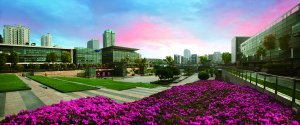
KIC has also become a magnet for young creative workers and has put Yangpu on the map as a living and working destination; some local media have referred to KIC as “Shanghai’s Uptown.” Just one Metro stop north of KIC, U.S. developer Tishman Speyer is now developing a large, new mixed-use project anchored by Nike, which quite likely would not have been possible in Yangpu without KIC’s place making efforts.
Creating an innovation cluster is far more complex than completing a real estate project, and no question exists that Shui On Land’s coordination of educational, corporate, workforce, and financial resources has taken time and effort that have reduced the simple return of the project from a real estate perspective. Only recently, over a decade after the project’s inception, have all the different pieces been assembled and the synergies between universities, multinational corporations, startups, and financers started to bear fruit. Shui On Land’s approach might not be possible for companies that do not have deep pockets and long-term vision, or ones that face pressure to produce quarterly returns. But for developers that can take a long-term approach to place making, KIC stands as a great lesson in how to turn an industrial center into an engine for innovation.
Project Information
| Development Timelines | |
|---|---|
| Project planning started | September 2002 |
| Site acquired | March 2004 |
| Construction started | November 2004 |
| KIC Plaza Phase I opens | October 2006 |
| Jiangwan Stadium holds closing ceremony for 2007 Special Olympics | October 2007 |
| KIC Plaza Phase II opens | April 2010 |
| KIC Overseas Talent Tower and Shanghai Cloud Computing Innovation Base inaugurated | October 2010 |
| IPO Club Entrepreneurship House opened | August 2011 |
| KIC Plaza Phase III completed | September 2011 |
| InnoSpace startup incubator opens | November 2012 |
| Project completion (projected) | June 2016 |
| Site Size | 49 hectares (121 acres) |
| Gross Building Area | ||
|---|---|---|
| Use | Area (sq m) | Percentage of total |
| Office (including live/work) | 218,776 | 28.7% |
| Retail | 67,641 | 8.9% |
| Residential | 127,980 | 16.8% |
| Hotel | 15,286 | 2.0% |
| Fundan EMBA | 100,000 | 13.1% |
| Educational | 11,968 | 1.6% |
| Underground parking | 220,566 | 28.9% |
| Total | 762,217 | 100.0% |
| Office Information | ||||
|---|---|---|---|---|
| KIC Plaza | KIC Corporate Avenue | KIC Village SOHO | Total | |
| Number of buildings | 15 | 7 | 4 | 26 |
| Range of floors per building | 4–8 | 10 | 10–12 | |
| Overall occupancy | 99% | |||
| Total office space | 101,669 sq m | 88,610 sq m | 28,497 sq m | 218,776 sq m |
| Major office tenants | ||||
| IBM Global Delivery Center | ||||
| EMC2 Research and Development Group | ||||
| China Telecom | ||||
| Oracle R&D Center | ||||
| Deloitte | ||||
| VMware and Shanghai Cloud Computing Innovation Base | ||||
| eBaoTech | ||||
| One office building sold in 2011 to the Industrial and Commercial Bank of China for RMB 600 million (US$94 million) | ||||
| Residential Information | |||
|---|---|---|---|
| KIC Village | Jiangwan Regency | Total | |
| Number of units | 709 | 240 | 949 |
| Number of buildings | 18 | 7 (5 mid rise, 2 low rise) | 25 |
| Total residential space | 78,449 sq m | 49,531 sq m | 127,980 sq m |
| Percentage of units sold | 100% | ||
| Sales prices | RMB 28,000/sq m | RMB 40,000/sq m | |
| Unit sizes | 70–130 sq m | 170–200+ sq m |
| Retail Information | ||||
|---|---|---|---|---|
| KIC Plaza | KIC Village | Jiangwan Stadium | Total | |
| Number of units | Service F&B for office tenants, educational and training | Independent retailers, international cuisine, active lifestyle | Sports and leisure | |
| Retail occupancy | 90% | |||
| Total retail space | 45,173 sq m | 13,670 sq m | 8,798 sq m | 67,641 sq m |
| Hotel Information | |
|---|---|
| Rooms | 146 |
| Building area | 15,286 sq m |
| Room size | 30–92 sq m |
| Operator to be determined | |
| Financing Information | |
|---|---|
| Total investment | |
| Approximately RMB 10 billion (US$1.6 billion) | |
| Initial equity investment* | |
| Shui On Land | 70% |
| Shanghai Yangpu University City Investment and Development Co. Ltd. | 30% |
| *Shui On reduced debt and increased equity share over time as the project was developed. The Shanghai Yangpu share of equity was reduced over time to 13%. | |
Format
Full
City
Shanghai
Country
China
Metro Area
Shanghai
Project Type
Mixed Use
Location Type
Other Central City
Land Uses
Fitness Center
Hotel
Multifamily Rental Housing
Office
Restaurant
Retail
Keywords
Adaptive use
Green building
Innovation district
Live/work space
Pedestrian-friendly design
Science city
Technology companies
Site Size
121
acres
acres
hectares
Date Started
2002
Date Opened
2016
Website
www.shuionland.com/en-us/property/project/
detail/shanghai_kic
Project address
Shui On Development Limited
Knowledge and Innovation Community Project
B1/F, Building 10, KIC Plaza
290 Songhu Road, Yangpu District
Shanghai 200433
Developer
Shui On Land
Shanghai, China
www.shuionland.com
Public sector development partner
Shanghai Yangpu University City Investment and
Development Co. Ltd.
Shanghai, China
Master planners
Skidmore, Owings and Merrill (SOM)
www.som.com
ARUP Group Limited
www.arup.com
Shanghai Urban Planning and Design
Research Institute
www.supdri.com
DESIGNERS, CONTRACTORS,
AND CONSULTANTS
Architects
Skidmore, Owings & Merrill (SOM) LLP
www.som.com
P&T Architects and Engineers Ltd.
www.p-t-group.com
Gensler
www.gensler.com
Arte Charpentier Architects
www.arte-charpentier.com/en/
Farrells
www.terryfarrell.co.uk
Ben Wood Studio Shanghai (BWSS)
studioshanghai.co
Leigh & Orange
web.leighorange.com
Hassell
hassellstudio.com
3XN
www.3xn.com
Executive architects and engineers
P&T Architects and Engineers Ltd.
www.p-t-group.com
Architectural Design and Research
Institute of Tongji University
www.tjadri.com
Atkins
www.atkinsglobal.com
AECOM
www.aecom.com
Tianhua Architecture
www.thape.com.cn
Research Assistants and
Translators
Abel Xu, Senior Associate, Huhan Advisory
Cindy Zhang, Analyst, Huhan Advisory
Rebecca Chen, Intern, Wellesley College
